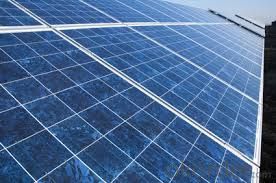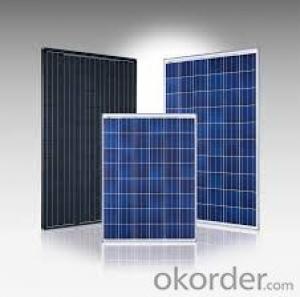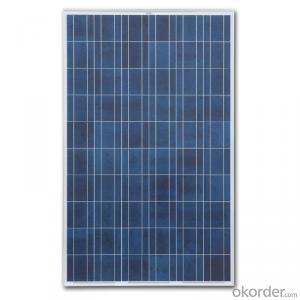Clear Solar Cells Polycrystalline Solar Panel with Factory Price High Efficiency CNBM
- Loading Port:
- Qingdao
- Payment Terms:
- TT OR LC
- Min Order Qty:
- 10 set
- Supply Capability:
- 300000 set/month
OKorder Service Pledge
OKorder Financial Service
You Might Also Like
Polycrystalline Solar Modules
CNBM offers a range of small, medium and large polycrystalline solar modules, designed for a range of requirements.


Specifications:
Tolerance | +/-3% |
Cell | Polycrystalline silicon solar cells (156 x 156mm) |
N0. of Cells | 60 (10 x 6) |
Dimension of Modules (mm) | 1650 x 990 x 40 |
Weight (kg) | 25.5 |
Limits:
Operating Temperature | -40~+85? |
Storage Temperature | -40~+85? |
Maximum System Voltage | 1000 VDC max. |
Hail Impact | Diameter of 28mm with impact speed |
Temperature and Coefficients:
NOCT | 48C+/-2? |
Voltage temperature coefficient (%/K) | -0.35 |
Current temperature coefficient (%/K) | 0.05 |
Power temperature coefficient (%/K) | -0.45 |
Characteristics:
Model: | SGM-200P | SGM-210P | SGM-220P |
Max-power voltage Vmp (V) | 29.2 | 29.4 | 29.41 |
Max-power current Imp (A) | 6.85 | 7.14 | 7.48 |
Open-circuit voltage Voc (V) | 36.5 | 36.69 | 36.9 |
Short-Circuit Current Isc (A) | 7.28 | 7.6 | 7.93 |
Max-power Pm(W) | 200 | 210 | 220 |
Model: | SGM-230P |
Max-power voltage Vmp (V) | 29.8 |
Max-power current Imp (A) | 7.72 |
Open-circuit voltage Voc (V) | 37.31 |
Short-Circuit Current Isc (A) | 8.19 |
Max-power Pm(W) | 230 |
STC: Irradiance 1000W/m2, module temperature 25?, AM-=1.5
Poly Crystalline Solar Panels Specifications Range
Maximum Power (Pm) | Dimension | Weight | Operating Voltage (Vmp) | Operating Current (Imp) | Open Circuit Voltage (Voc) | Short Circuit Current (Isc) |
0.45W | 140x80x10mm | 0.08kg | 3.3V | 150mA | 4.6V | 160mA |
1.0W | 162x140x10mm | 0.16kg | 7.5V | 150mA | 10.3V | 160mA |
4.5W | 269x251x23mm | 0.8kg | 16.5V | 0.27A | 20.5V | 0.3A |
10W | 420.1×268.9×22.6mm | 1.92kg | 17.5V | 0.58A | 20.5V | 0.6A |
20W | 425x502x50mm | 3.0kg | 16.8V | 1.19A | 21.0V | 1.29A |
30W | 593x502x22.6mm | 3.9kg | 16.8V | 1.78A | 21.0V | 1.94A |
40W | 655x537x50mm | 5.75kg | 17.3V | 2.31A | 22.1V | 2.54A |
50W | 839x537x50mm | 6.0kg | 17.5V | 2.9A | 21.8V | 3.17A |
65W | 1111x502x50mm | 7.2kg | 17.6V | 3.69A | 22.1V | 3.99A |
80W | 1204x537x50mm | 7.7kg | 17.6V | 4.55A | 22.1V | 4.8A |
- Q: What is the solar cell production process
- Solar cells are the core devices in the PV power generation system. Energy saving is a kind of device that uses the principle of photoelectric conversion to convert the radiated light of the sun into electrical energy through the semiconductor material. This photoelectric conversion process is usually called "photovoltaic effect", so the sun
- Q: Are solar cells affected by extreme temperatures?
- Yes, solar cells can be affected by extreme temperatures. High temperatures can cause the efficiency of solar cells to decrease, as excessive heat can cause an increase in resistance and reduce the voltage output. Similarly, extremely cold temperatures can also impact their performance, although to a lesser extent. It is important to note that modern solar cells are designed to withstand a wide range of temperatures, and their efficiency is typically optimized within a specific temperature range.
- Q: Are there any health risks associated with solar cells?
- There are no direct health risks associated with solar cells themselves. However, the manufacturing and disposal processes of solar panels can have some environmental impacts and potential health risks if not managed properly.
- Q: How do solar cells perform in areas with high levels of wildfire smoke?
- Solar cells can experience a decrease in performance in areas with high levels of wildfire smoke due to reduced sunlight reaching the surface. The smoke particles in the air can scatter and absorb sunlight, resulting in lower energy production. Additionally, the deposition of ash and soot on the solar panels can further reduce their efficiency. Regular cleaning and maintenance can help mitigate these effects to some extent.
- Q: Can solar cells be used to power remote weather stations?
- Yes, solar cells can be used to power remote weather stations. Solar cells convert sunlight into electricity, providing a reliable and sustainable power source for remote locations. This eliminates the need for traditional power grid connections and reduces operating costs. Additionally, solar cells can be easily installed and maintained in remote areas, making them an ideal solution for powering weather stations in such locations.
- Q: Can solar cells be used for powering schools?
- Yes, solar cells can be used to power schools. Solar energy is a renewable and sustainable source of power, and installing solar panels on school rooftops or grounds can generate electricity to meet the energy needs of schools. This can significantly reduce the reliance on fossil fuels and decrease carbon emissions, making it an environmentally friendly solution. Additionally, solar power can provide a reliable and consistent energy source, especially in sunny regions, ensuring schools have a stable power supply.
- Q: Can solar cells be used for powering data centers?
- Yes, solar cells can be used to power data centers. Solar energy can be harnessed through photovoltaic panels to generate electricity which can then be used to power the infrastructure of data centers. This renewable energy source can help reduce the carbon footprint and dependency on fossil fuels, making data centers more sustainable and environmentally friendly.
- Q: Can solar cells be used for powering water pumps?
- Yes, solar cells can be used for powering water pumps. Solar-powered water pumping systems utilize photovoltaic cells to convert sunlight into electricity, which can then be used to power water pumps. These systems are environmentally friendly, cost-effective, and reliable, making them a popular choice for remote areas or locations where grid electricity is not available.
- Q: What is the role of solar cells in solar-powered water heaters?
- The role of solar cells in solar-powered water heaters is to convert sunlight into electricity. These cells are typically made of silicon and absorb photons from the sun, generating an electrical current. This electricity is then used to power the water heater, which heats the water using the sun's energy. So, solar cells are crucial in harnessing solar energy and enabling the water heater to operate efficiently without relying on traditional electricity sources.
- Q: Can solar cells be used in educational institutions?
- Yes, solar cells can definitely be used in educational institutions. In fact, they can serve as valuable teaching tools for students to learn about renewable energy, sustainability, and the importance of reducing carbon footprint. By installing solar cells on the premises, educational institutions can also save on electricity costs and set an example for the community by embracing clean energy solutions.
Send your message to us
Clear Solar Cells Polycrystalline Solar Panel with Factory Price High Efficiency CNBM
- Loading Port:
- Qingdao
- Payment Terms:
- TT OR LC
- Min Order Qty:
- 10 set
- Supply Capability:
- 300000 set/month
OKorder Service Pledge
OKorder Financial Service
Similar products
Hot products
Hot Searches
Related keywords


























